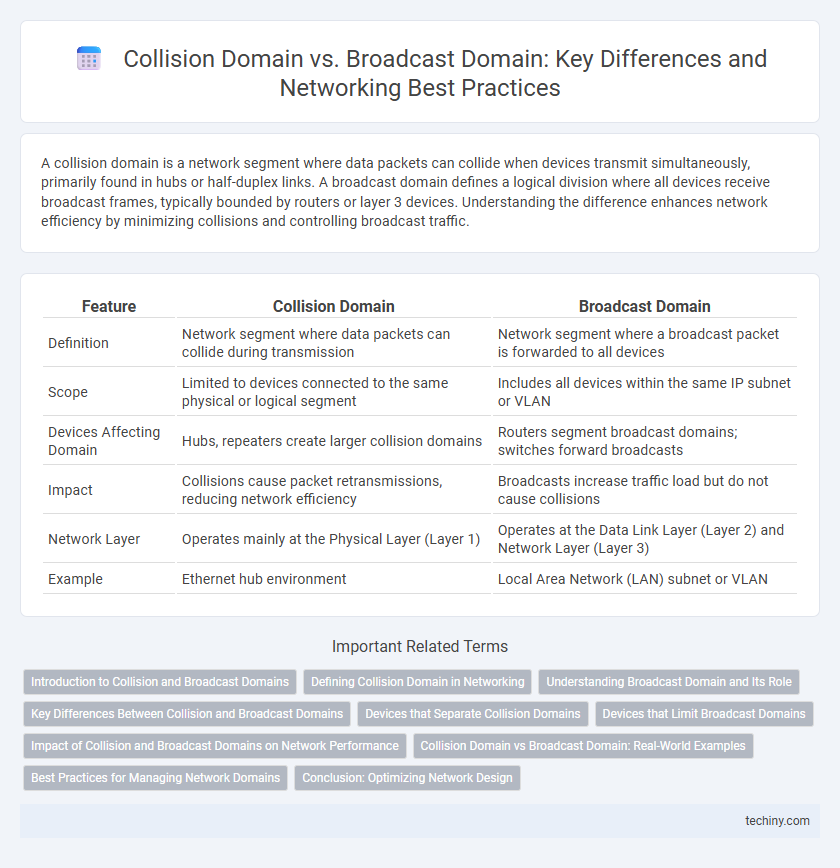A collision domain is a network segment where data packets can collide when devices transmit simultaneously, primarily found in hubs or half-duplex links. A broadcast domain defines a logical division where all devices receive broadcast frames, typically bounded by routers or layer 3 devices. Understanding the difference enhances network efficiency by minimizing collisions and controlling broadcast traffic.
Table of Comparison
| Feature | Collision Domain | Broadcast Domain |
|---|---|---|
| Definition | Network segment where data packets can collide during transmission | Network segment where a broadcast packet is forwarded to all devices |
| Scope | Limited to devices connected to the same physical or logical segment | Includes all devices within the same IP subnet or VLAN |
| Devices Affecting Domain | Hubs, repeaters create larger collision domains | Routers segment broadcast domains; switches forward broadcasts |
| Impact | Collisions cause packet retransmissions, reducing network efficiency | Broadcasts increase traffic load but do not cause collisions |
| Network Layer | Operates mainly at the Physical Layer (Layer 1) | Operates at the Data Link Layer (Layer 2) and Network Layer (Layer 3) |
| Example | Ethernet hub environment | Local Area Network (LAN) subnet or VLAN |
Introduction to Collision and Broadcast Domains
A collision domain is a network segment where data packets can collide during transmission, typically found in half-duplex environments like hubs or legacy Ethernet setups, causing network inefficiency. A broadcast domain is a logical division in a network where all devices receive broadcast frames, usually bounded by routers or VLANs to limit traffic and enhance performance. Understanding the distinction between collision and broadcast domains is crucial for network design and optimizing traffic flow.
Defining Collision Domain in Networking
A collision domain in networking refers to a network segment where data packets can collide when two devices attempt to send data simultaneously on a shared medium. Collision domains are common in traditional Ethernet environments using hubs or repeaters, where only one device can successfully transmit at a time. Segmenting collision domains with switches or bridges reduces collisions and improves overall network performance by isolating traffic to individual ports.
Understanding Broadcast Domain and Its Role
A broadcast domain is a logical division of a computer network where any broadcast sent by a device is received by all other devices within the same domain, typically defined by routers that do not forward broadcast traffic. Understanding the role of a broadcast domain is crucial for network segmentation and management, as it helps reduce unnecessary traffic and improve overall network performance. Devices within a broadcast domain share the same subnet and rely on switches and VLANs to control the extent of broadcast reach, preventing network congestion and enhancing security.
Key Differences Between Collision and Broadcast Domains
Collision domains are network segments where data packets can collide when devices transmit simultaneously, primarily occurring in half-duplex Ethernet environments. Broadcast domains define network segments where a broadcast frame is forwarded to all devices within that domain, typically bounded by routers. Key differences include collision domains being reduced by switches to minimize packet collisions, while broadcast domains are segmented by routers to contain broadcast traffic and improve network efficiency.
Devices that Separate Collision Domains
Switches and bridges are primary devices that separate collision domains by creating distinct network segments, allowing multiple devices to transmit simultaneously without collisions. Each port on a switch represents an individual collision domain, significantly reducing the chances of data packet collisions compared to hubs. Routers also separate collision domains but primarily function to separate broadcast domains by directing traffic between different IP subnets.
Devices that Limit Broadcast Domains
Network switches and routers are critical devices that limit broadcast domains by controlling the scope of broadcast traffic within a network. Routers inherently separate broadcast domains by not forwarding broadcast packets between interfaces, ensuring segmented network traffic. Managed switches with VLAN capabilities further isolate broadcast domains by logically dividing a single physical switch into multiple virtual networks.
Impact of Collision and Broadcast Domains on Network Performance
Collision domains restrict network performance by causing data packet collisions, leading to retransmissions and increased latency, which degrades overall throughput in shared media environments such as hubs or half-duplex switches. Broadcast domains influence network efficiency by propagating broadcast traffic to all devices within the domain, potentially overwhelming bandwidth and causing broadcast storms that reduce available resources for legitimate traffic. Segmentation through switches, routers, or VLANs minimizes collision and broadcast domains, optimizing network traffic flow and enhancing performance scalability.
Collision Domain vs Broadcast Domain: Real-World Examples
Collision domains are commonly observed in traditional Ethernet hubs where multiple devices share the same communication channel, leading to frequent data collisions and network inefficiencies. Broadcast domains are seen in VLAN-configured switches, where broadcast traffic is contained within specific VLANs, improving network segmentation and security. Real-world examples include legacy office networks using hubs exhibiting large collision domains versus modern enterprise networks using VLANs to minimize broadcast domains and optimize traffic management.
Best Practices for Managing Network Domains
Segmenting collision domains using switches instead of hubs reduces network collisions and enhances performance by isolating traffic at the port level. Managing broadcast domains effectively involves implementing VLANs to limit broadcast traffic, improve security, and optimize bandwidth utilization across the network. Regularly monitoring domain sizes and traffic patterns ensures optimal segmentation, preventing congestion and enhancing overall network efficiency.
Conclusion: Optimizing Network Design
Optimizing network design requires minimizing collision domains by using switches instead of hubs to reduce data packet collisions and enhance throughput. Segmenting broadcast domains with routers or VLANs limits unnecessary traffic, improving overall network performance and security. Efficient management of both domains leads to scalable, reliable, and high-performing network infrastructures.
Collision Domain vs Broadcast Domain Infographic

 techiny.com
techiny.com